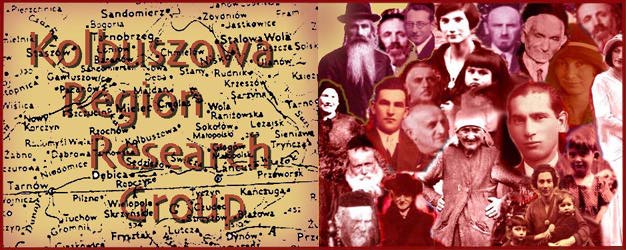


Ulanów and surrounding towns (from a Travel Brochure)
Editor’s note: The translation
is handwritten, making it difficult to read, so please excuse any
spelling errors (especially of town names).
Today's region of Zeshow is on the south eastern end of Poland.
It has a direct connection with the ocean through the Rivers Vistula
and San. They cross the area Mielec, Tarnobzeg and towns: Ulanów, Uscryki, Lesko, Sanok,
Bzozow, Premysl, Jaroslaw, Lezaj, Nizan and Tarnobzeg.
That rich body of water was in the past a significant way of
transportation, connecting Sanok and Pzemysl with the economic and
cultural places of our country: Warsaw, Bydgose[?], Torun, Gdansk.
Near the San by Premysl were warehouses of salt mines.
Subsequently, the beginning of the San River was the opening for port
cities: Ulanów, Radymno,
Jaroslaw, Nielepkowice, Trynera, Sieniawa, Lezaj___, Bieliny (?),
Kzesrow, Radomysl.
The first most important port on the San River was Jaroslow.
There were huge warehouses, similar to the ones we can see still today
in Torun and Gdansk. Grain was shipped to Gdansk from the port of
Jaroslow, food product to Warsaw, wicker baskets and others to
Radymno. Ships were built and repaired in Ulanów, Jaroslaw, Nielepkowice, and
Sandomier.
Ulanów was an important steady
rafting place. The good location helped the development of the
city- by the River and near two large deep forests, Sandomier and
Solski.
The origin of Ulanów was
established by an archeological dig, which revealed that man settled
there at least 6000 years ago. The oldest historic reference was
found in a chronicle by Jan Dlugosz in “Liber Bene Ficiorum”, where he
describes that because of the convenient location many ships and rafts
with merchandise stopped in Ulanów.
[Ulanów’s beginnings] In
the beginning of XVII century, the owner of the village Beilin was an
industrialist Stanislaw De Ulina Magna Ulinski, who in 1616 got
permission by King Zygmunt III to establish a city based on Magdeburg’s
Law. The city was self governed and had the freedom to develop
within its boundaries. The residents had no restrictions and were
happy with their freedom. The local authorities were divided into
two branches: Administrative and Judiciary. The judiciary
had a lot of power. The founder gave his name to the city,
Ulinow, but later it was changed to Ulanów. Stanislaw De Ulina
Magna Ulinski had a coat of arms with a stamp “Dolenga”, made out of
silver with an arrow in the middle and a cross on a blue horse shoe
shaped background. This was also the coat of arms of the city,
displayed in the City Hall, until it was destroyed during the war by
the occupants.
Ulanów’s residents worked as craft men (?), blacksmiths, made clothing
and built bouts and rafts. Watermanship (?) was the most popular
occupation. They organized an association, elected a Head
Maste___ (?) “older brother (?)”, had special privileges.
A significant battle with Sweden took place near Ulanów.
In 1809, Josef Poniatowski fought the Austrian army from his
headquarters in Ulanów.
Ulanów was situated on the border between Austria and Russia during the
partition. It was a good place for contact particularly at the
November uprising. The residents of Ulanów took an active part in
the January uprising and in the People’s Spring revolt. Ulanów
was the place of “resistance” from the beginning of the occupation till
the end of W.W.II. They also supported the partizan groups in
their activities against Hitler’s well formed army.
In 1944, after the Red Army liberated Ulanów, the city rebuilt
communal, educational and cultural activities.
Lately Huta Stalowa Wola established a resort place for their
employees, also available for tourists, because of the good
geographical location. Hopefully, other industrial establishments
will be interested in new commercial modern enterprises in Ulanów.
Ulanów distinguishes herself with its beautiful geographical location
in the middle, between the Rivers San and Tanwia, surrounded with old
rests, that reach the city streets. Great (?) fresh air, not
polluted with factory smoke. Bathing is possible in the San (?)
River water. It is a peaceful and quiet place for tourists, who
want to get away from community and industrial pressures.
Ulanów is “the place” thanks to the beautiful landscaping, nice old
landmarks U interesting history of the land.
Ulanów has a direct bus connection to many cities: Zeshow---70
km.; Zamose (?)---105 km.; Rudnik---7 km.; Nisko---7 km. One can
reach Rudnik & Nisko by train. Railway track 555--- Pzewrsk
(?)-Rozwadow.
It’s worth while to visit the original market place with interesting
houses from the 19th century, a parochial church with beautiful art on
the walls, a brick house, a balcony that Poniatowski resided in
1809. It is also noteworthy to mention the old wooden church from
the 17th century and the graves on the cemetery of the revolutionaries
from 1830, 1863 and the participants of W.W.I and W.W.II.
From Ulanów one can organize excursions to near and far places.
The roads are full of beautiful flowers through fields and woods and
are conducive for vacations. San and Tanwia rivers assure many
romantic attractions and water sports.
© Copyright 2017 Kolbuszowa Region Research Group. All rights reserved.